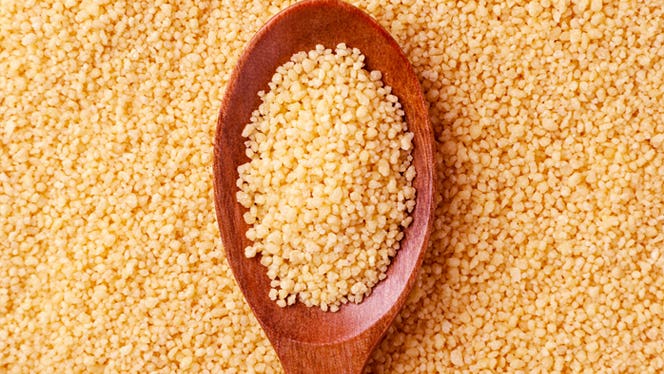
Couscous, Explained: Everything You Need to Know About Cooking with the Grain-like Staple
What looks like a grain, cooks like rice, and is actually a type of pasta? Couscous! Tender and creamy with a pleasing chewiness, couscous has been a staple starch in North Africa for centuries. And now that whole wheat couscous is readily available to home cooks, couscous is an excellent ingredient to have on hand in a whole-food, plant-based pantry. Here’s everything you need to know about couscous, including how to select and cook with the different types you come across in recipes.
What Is Couscous?
Couscous is believed to have originated in Northwest Africa around 2,000 years ago. The versatile starch is made with semolina (durum wheat) flour, water, and salt—just like most pastas. But while pasta dough is rolled, cut, and molded into different shapes, couscous is made by rubbing or shaping the dough into small granules or bead-shaped pellets that are then dried for extended storage. Traditionally, couscous was steamed until soft and ready to eat. Nowadays, most cooking instructions call for it to be boiled or, for fine-grained North African–style couscous, merely plumped in boiling-hot water for a few minutes before serving.
Types of Couscous and How to Cook with Them
When shopping for couscous, the first thing to look for is a brand that is made with whole wheat. After that, there are three types to choose from.
Moroccan Couscous
Also known as North African or Tunisian couscous, this is the type most people think of when they think of couscous, with small irregular granules and a super-quick cooking/steeping time of five minutes. Medium-grain couscous is the most common in North American groceries, but you can find fine-grain couscous through online and specialty retailers.
Cooking Instructions: Place 1 cup couscous in a heatproof container with a pinch of salt. Stir in 1 cup boiling water. Cover, and let stand 5 minutes, or until the granules are plump and tender. Fluff with a fork, then serve or add to recipes.
Ways to Use It: Moroccan couscous is ideal for warm pilafs, cold grain salads, stuffed vegetables, and can be used as a substitute for quinoa or millet. Fine-grain couscous also makes an excellent soup thickener.
Pearl Couscous
Perfectly round and deliciously chewy, pearl couscous (aka Israeli couscous or ptitim) was developed in Israel in the 1950s as an alternative to rice. The pearls are larger than Moroccan couscous, and they’re often pre-toasted to give them a rich, nutty flavor. Some argue that pearl couscous is not couscous in the original, North African sense, because it’s made by extruding dough through a die, rather than by rolling it into granules. But in the U.S., the term “couscous” is used more loosely, encompassing pearl varieties as well as the more traditional Moroccan styles. Pearl couscous can be used like Moroccan couscous in recipes; just be sure to adjust cook times.
Cooking Instructions: Bring 1¼ cups lightly salted water to a boil. Add 1 cup pearl couscous; cover. Reduce heat to medium-low, and simmer 10 to 15 minutes, or until all the liquid is absorbed. Remove from heat, and let stand 3 to 5 minutes before fluffing and serving.
Ways to Use It: Pearl couscous is delicious in hot and cold side dishes, grain bowls, and salads. Try in place of pasta and noodles in soups and stews.
Lebanese Couscous
Moghrabieh, or Lebanese couscous, is larger than Israeli couscous, and it’s sometimes called pearl couscous as well. It’s the defining ingredient in a popular Lebanese stew made with chickpeas, onions, spices, and meat.
Cooking Instructions: Bring a large pot of salted water to a boil. Add 1 cup Lebanese couscous, and boil 20 to 23 minutes, or until tender. Drain and serve.
Ways to Use It: With its large granules, Lebanese couscous makes a great addition to soups, stews, and hearty salads. Try sprinkling over tossed salads like croutons for added texture.
Flavored and Tri-Color Couscous
As tempting as flavored couscous blends and tri-color couscous medleys may sound, they are usually made with refined semolina flour and seasoned with a lot of salt. Forks Over Knives recommends always checking ingredient labels and opting for whole grain, low-sodium products.
What’s the Difference Between Couscous and Bulgur?
Bulgur is a whole grain made by cracking steamed, dried wheat berries into small pieces. It has a similar taste and texture to North African couscous, but a longer cooking time (10 to 15 minutes).
Is Couscous Gluten-Free?
Couscous made with semolina/durum wheat is not gluten-free. Some specialty brands now offer both Moroccan and pearl couscous products made from gluten-free bases such as rice, corn, and cassava. If gluten is an issue and you can’t find a gluten-free couscous, try millet in place of fine-grain couscous or substitute sorghum for pearl/Israeli couscous.
Tasty Couscous Recipes to Try
Here are a few easy recipes that call for the different types of couscous. Give them a whirl, or use the ideas as a jumping off point for your own dishes.
- Harissa Cauliflower Steaks with Date Couscous
- Farmers Market Couscous Salad
- Date and Orange Couscous Salad
- Easy Herbed Couscous
- Healthy Couscous Bowls
- Spiced-Couscous Cucumber Bites
- Blooming Tomatoes with Couscous Pilaf
- Vegan Mushroom Scallops with Spanish-Style Olive-Herb Sauce
- Falafel Waffles with Tomato Salad and Tahini Sauce
- Kid-Friendly Rainbow Salad
About the Author

About the Author
Mary Margaret Chappell
Join our mailing list
Get free recipes and the latest info on living a happy, healthy plant-based lifestyle.
By providing your email address, you consent to receive newsletter emails from Forks Over Knives. We value your privacy and will keep your email address safe. You may unsubscribe from our emails at any time.
